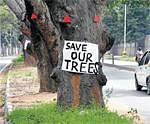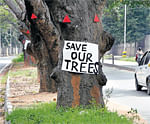

Although there have been massive protests from green groups to save the green patch on this stretch, Bruhat Bangalore Mahanagara Palike (BBMP) is expected to start the work anytime.
Recently, an environment NGO, Ashoka Trust for Research in Ecology and the Environment (ATREE) conducted a survey on trees that were marked for uprooting. The survey, headed by Dr Harini Nagendra, Urban Ecological Coordinator, ATREE, found that there are several massive exotic species of rain trees including African tulips and Copper pods which form large canopies. These trees have been around for over 150 years.
The survey was conducted in three sections, where the first dealt with the pavements on these roads which had 183 trees of 15 species. However, there are chances of saving a few trees here by incorporating them into road medians. The second section dealt with the area within the Palace compound, on the eastern edge of Bellary Road, between Mekhri Circle and the flyover near Windsor Manor. This stretch has 525 trees of 26 species and was found to have a greater biodiversity.
The third section on Jaymahal Road, between the Cantonment bridge and Mekhri Circle, has over 515 trees with a diverse set of 30 species. A number of bird nests were also observed on taller trees here, indicating the importance of these habitats for bird population in the neighbourhood.
Environmental impact
The survey found that trees on these roads reduce mid-day air temperature by five to seven degrees Celsius and the road surface temperatures by 30 degrees Celsius. From the size, it is clear that these huge trees are decades old and uprooting them will have a major impact on the urban heat islands, biodiversity, air pollution and temperature in this area.
Dr Harini says that it is important to carefully consider 'mitigation strategies' while dealing with the environmental issues. "First, we should disabuse ourselves of the notion that the environmental and ecological benefits provided by a large mature tree can be easily replaced in a short time frame by planting a number of small saplings. It takes years for a sapling to reach the size of a large mature tree, and provide similar benefits," she said.
Also, the survival rate of saplings planted in the urban context is often quite poor, and many of these saplings may not survive to maturity in the first place. Thus, it is important to first prioritise the efforts to determine alternatives to road widening in this area, she added.